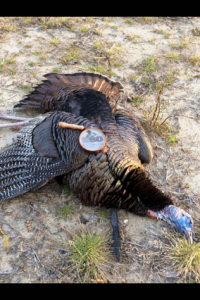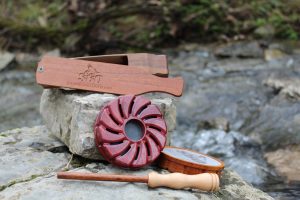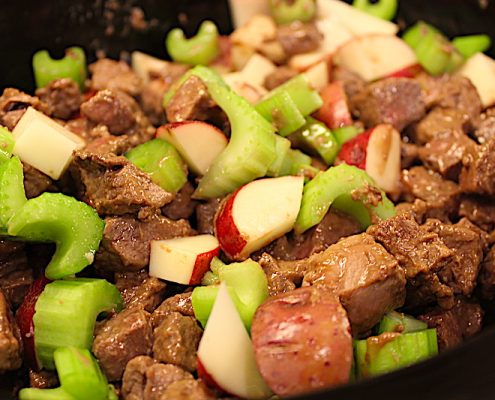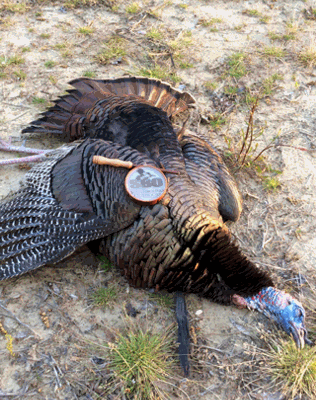Turkey Decoy Tactics

As a lifelong waterfowler, I’ve got a soft spot for decoys. When I first started turkey hunting, I found it difficult to only walk into the woods with two or three decoys. I wanted to look like a whole flock and bring all the toms running from miles around! However, I’ve learned a more finesse approach is required. Sometimes you can kill turkeys with no decoys whatsoever, and that’s fine. However, I really like having decoys out to draw attention away from myself (and my kids), giving me greater ability to make lethal shots. Here are some of the turkey decoy tactics I’ve used with success, please share your tips with me as well.
Scout, Scout, Scout
As with pretty much any type of hunting, scouting is key to turkey hunting. If you want the best guidance for your turkey decoy setup, watch what your local flocks are doing. Are you seeing large flocks of hens with two or three gobblers? You’re probably safe putting out a few more hens and a strutter decoy. Are you seeing single hens walking around mid-morning? The hens may have started nesting, so you’re probably better suited to setup with a single hen decoy and hunt through lunch. Learn to read the birds, and they’ll tell you what type of turkey decoy setups to use.
Early Season vs. Late Season
Much of this is weather dependent, so rely on your scouting and knowledge of the area to guide your turkey decoy strategy. However, in general, early in turkey season you’ll see the birds still bunched up in flocks. In my experience, the early season will still have 10-12 hens in a flock with 2-4 gobblers strutting around at the same time. So, early in the season, I’ll run 3 or more hen decoys and a strutting tom or half-strut jake decoy. Basically, if turkeys are still bunched up, I want the gobblers in my area to think a few hens have broken away, and another tom is displaying for them. It’s difficult to pull a gobbler away from a flock of hens by using a single hen decoy. He’s much more likely to come to multiple hens, especially if there’s a challenger with them.
Later in the season, as the hens start laying eggs and sitting on nests, you’ll see more single hens roaming around throughout the day. So, as the season wears on, I’ll set up a single hen turkey decoy, or maybe a hen and a jake. Hens will fly down early in the morning, breed with a tom, and then head off to check on their nest and sit for a while. So, gobblers will be out searching for hens who have left the nest and are ready for another rendezvous. Presenting a single hen decoy or a hen and jake combo will seem very realistic to the tom.
When to Use a Jake
Jake decoys are very popular, with a common combo pack of turkey decoys being two hens and a jake. The jake turkey decoy can be a powerful draw for a gobbler, but can also be detrimental in certain circumstances.
Basically, whether you should use a jake decoy or not depends on the makeup of your local flock. Often, a jake decoy with a hen can cause a gobbler to become irate. He’ll come charging in, ready to show this youngster that he’s the dominant bird in the area. With this situation, you’ll want to place your jake turkey decoy, not the hen, in your primary shooting lane, as the gobbler will most likely go to the jake before the hen.
However, in some areas, jakes will bunch up during the Spring. You’ll see groups of jakes, often with 4 or more individuals traveling together. These jake flocks will beat up on individual mature toms, causing these mature birds to become skittish of running into jakes. If you notice a group of jakes roaming around your hunting property, you might just double up on the hen decoy and leave the jake decoy at home.
When to Use a Strutter
There are several uses for a full-strut tom turkey decoy during the Spring turkey season. As mentioned earlier in this article, you can use them with success early in the Spring when turkeys are bunched up. This will make dominant toms believe there is a challenger pulling hens away, and the mature birds will come to meet the new challenger.
A method of turkey hunting that has gained popularity recently is fanning, also called turkey reaping. This is the process of crawling towards a tom turkey while hiding behind a strutting tom decoy. This makes the live bird believe a challenger is coming towards them, and often causes the gobbler to come running at the challenger ready for a fight. There are special decoys made for this purpose with features such as gun mounts, handles, and safety orange flags.
I have heard some people say they won’t use a full strut tom decoy, as it seems to scare away inferior mature birds. If there is a particularly dominant tom in the area, and he’s constantly beating up on everyone, this might be true. However, if you notice a gobbler get scared away by a full strut decoy, you can assume there is a larger dominant bird in the area. So, then you can go after him, and know that your strutting tom turkey decoy will bring him running.
Motion
As a hunter coming from a largely-waterfowl focused upbringing, I immediately think of ways to make decoys move. With ducks and geese, you need the motion to bring reality into the decoy spread. However, if you watch turkeys in the wild, there may be decently-long periods of time where they are mostly motionless. When toms are strutting, they are largely motionless other than a little drumming and turning. Hens move around and feed, but it’s not uncommon for them to watch the approach of a strutting tom with very little movement.
Even so, motion will make your turkey decoy setup that much more noticeable and realistic. Placing the decoy on a stake and clearing the grass from around the decoy will allow it to bob and spin with the wind. For calm days, you can use a type of jerk string or even a battery operated system like the one from Motion Madness Decoys to make the hen decoy simulate feeding. There are even systems now that feature a jake decoy standing on top of a hen decoy to simulate breeding, which will really get those toms fired up! So, motion can make a difference when turkey hunting, but it’s not absolutely necessary for success.
Wrap Up
If you only take one thing away from this article, understand that scouting should dictate your turkey decoy strategy. Knowing how the birds are responding to weather patterns, what they’re eating, and what the age structure is of the flock will help you deploy the best turkey decoy tactics. Get out and try stuff, watching how real birds react and don’t be afraid to change your decoy setup throughout the season. By reading and responding to the birds, you’ll find more spurs and fans in the back of your truck each Spring.




